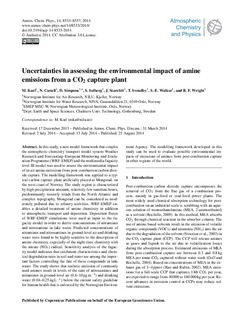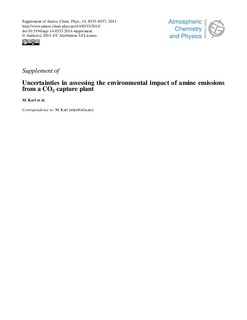| dc.contributor.author | Karl, Matthias | |
| dc.contributor.author | Castell, Núria | |
| dc.contributor.author | Simpson, David | |
| dc.contributor.author | Solberg, Sverre | |
| dc.contributor.author | Starrfelt, Jostein | |
| dc.contributor.author | Svendby, Tove Marit | |
| dc.contributor.author | Walker, Sam-Erik | |
| dc.contributor.author | Wright, Richard Frederic | |
| dc.date.accessioned | 2014-10-07T11:55:33Z | |
| dc.date.accessioned | 2014-10-20T07:59:20Z | |
| dc.date.available | 2014-10-07T11:55:33Z | |
| dc.date.available | 2014-10-20T07:59:20Z | |
| dc.date.issued | 2014 | |
| dc.identifier.citation | Karl, M., et al., 2014. Uncertainties in assessing the environmental impact of amine emissions from a CO2 capture plant. Atmos. Chem. Phys. Discuss. 14(6) 8633-8693 | nb_NO |
| dc.identifier.issn | 1680-7367 | |
| dc.identifier.uri | http://hdl.handle.net/11250/224161 | |
| dc.description.abstract | In this study, a new model framework that couples the atmospheric chemistry transport model system WRF-EMEP and the multimedia fugacity level III model was used to assess
the environmental impact of amine emissions to air from post-combustion carbon dioxide capture. The modelling framework was applied to a typical carbon capture plant artificially placed at Mongstad, west coast of Norway. WRF-EMEP enables a detailed treatment of amine chemistry in addition to atmospheric transport and deposition. Deposition fluxes of WRF-EMEP simulations were used as input to the fugacity model in order to derive concentrations of nitramines and nitrosamine in lake water. Predicted concentrations of nitramines and nitrosamines in ground-level air and drinking water were found to be highly sensitive to the description of amine chemistry, especially of the night time chemistry with the nitrate (NO3) radical. Sensitivity analysis of the fugacity model indicates that catchment characteristics and chemical degradation rates in soil and water are among the important factors controlling the fate of these compounds
in lake water. The study shows that realistic emission of commonly used amines result in levels of the sum of nitrosamines and nitramines in ground-level air (0.6–10 pgm−3) and drinking water (0.04–0.25 ngL−1) below the current safety guideline for human health enforced by the Norwegian Environmental Directorate. The modelling framework
developed in this study can be used to evaluate possible environmental impacts of emissions of amines from post-combustion capture in other regions of the world. | nb_NO |
| dc.language.iso | eng | nb_NO |
| dc.publisher | European Geosciences Union | |
| dc.relation.uri | http://www.atmos-chem-phys.net/14/8533/2014/acp-14-8533-2014.pdf | |
| dc.rights | Creative Commons Attribution License 3.0 | * |
| dc.rights.uri | https://creativecommons.org/licenses/by/3.0/ | * |
| dc.rights.uri | http://www.atmos-chem-phys.net/14/8533/2014/acp-14-8533-2014.html | |
| dc.title | Uncertainties in assessing the environmental impact of amine emissions from a CO 2 capture plant | nb_NO |
| dc.type | Journal article | nb_NO |
| dc.type | Peer reviewed | |
| dc.date.updated | 2014-10-07T11:55:34Z | |
| dc.rights.holder | © Author(s) 2014. | |
| dc.source.journal | Atmospheric Chemistry and Physics | |
| dc.identifier.doi | 10.5194/acpd-14-8633-2014 | |
| dc.identifier.cristin | 1126471 | |
| dc.relation.project | Norges forskningsråd: 199874 | nb_NO |


